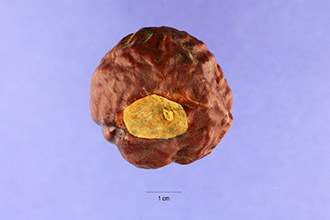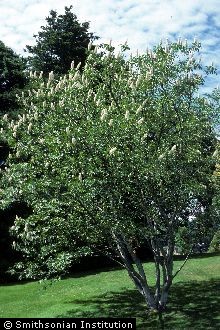California Buckeye
Scientific Name: Aesculus californica (Spach) Nutt.

| General Information | |
|---|---|
| Usda Symbol | AECA |
| Group | Dicot |
| Life Cycle | Perennial |
| Growth Habits | ShrubTree, |
| Native Locations | AECA |
Plant Guide
Alternate Names
Horse chesnut; Indian names: de-sa' ka-la' (Pomo); far'-sokt (Nomlaki); sympt'-ol (Yuki); ah'-te (Coast Miwok) , Use soil moisture sensors to measure the soil moisture of California Buckeye.
Uses
Ethnobotanic: This tree had multiple cultural uses among California Indian tribes. Many indigenous groups utilized buckeye seeds for food, often when other plant food sources were scarce. These tribes included the Costanoan, Salinan, Kitanemuk, Serrano, Wappo, Sierra Miwok, Coast Miwok, Chumash, Kawaiisu, Northern Maidu among others. The Pomo ate the seeds even when other important food plants were plentiful. The seeds are poisonous to humans in the raw state. Thus, the nuts were cracked open with a rock, the shells removed, the seeds pounded into flour, and their toxic saponins removed in a lengthy leaching process. The meal was subsequently cooked and eaten. There are many different methods for processing and cooking buckeye seeds for food, depending upon the tribe. The seeds have medicinal properties and were cut into pieces, mixed with water, and made into suppositories for hemorrhoids by the Costanoan and Kawaiisu. The Pomo cut bark from the base of the tree and made a poultice, which was laid on a snakebite. Young buckeye shoots were sometimes used as spindles or twirling sticks in fire-making kits of the Sierra Miwok, Northern Maidu, Wappo, Yahi and other tribes. Many tribes mashed buckeye nuts and poured the contents into quiet pools to stupefy or kill fish. Wildlife: Do not plant buckeyes near apiaries as the flowers are poisonous to honey bees. No wildlife eat buckeye seeds except squirrels, such as the California ground squirrel (Citellus beecheyi). Beatrice F. Howitt © California Academy of Sciences @ CalPhotos
Status
Please consult the PLANTS Web site and your State Department of Natural Resources for this plant’s current status (e.g. threatened or endangered species, state noxious status, and wetland indicator values).
Description
General: Buckeye Family (Hippocastanaceae). This native, deciduous shrub or tree reaches 12 m in height with a broad, rounded crown. The palmately compound leaves occur in leaflets of 5 to 7 and each leaflet is oblong-lanceolate and finely serrate. The inflorescence has many showy flowers in a panicle-like arrangement and it is erect, 1-2 dm. in length. Each individual flower has 4-5 petals and these are white to pale rose with 5-7 exserted stamens. The fruit is pear-shaped and smooth. The large, shiny light-brown seeds are 2-5 cm.
Distribution
For current distribution, please consult the Plant Profile page for this species on the PLANTS Web site.
Establishment
Adaptation: The California buckeye is one of the first shrubs to leaf out in spring and one of the earliest to shed its leaves in mid-summer. It is found on dry slopes, canyons and the borders of streams in many plant communities below 1700 m. in northwestern and central western California, Cascade Range, Sierra Nevada foothills, Tehachapi Mountains, Great Central Valley, and southwestern Mohave Desert. General: Harvest the large seeds from the tree or shrub about November. Plant them in the ground immediately--half buried in an area of full sun or light shade. There is a light spot on the seed, which is the growing point when being formed. The radicle will sprout from this area so make sure that this spot is covered with soil. Plant the seeds in a well-drained soil. Water the soil immediately after planting, and if there is not enough rain during the rainy season, supplement it with hand watering. The plants will also need some summer watering the first year so a good rule to follow is to keep the soil damp. The tree is a fast grower and can achieve as much as ten inches in height in one year. After buckeye seeds have been in the ground one full year, they should become established, and will not need continual care.
Management
When the shrub is mature, dead and dying branches can be lightly pruned if necessary. Cultivars, Improved and Selected Materials (and area of origin) These plant materials are readily available from commercial sources.
References
Beard, Y.S. 1979. The Wappo: A report. Malki Museum Press, Morongo Indian Reservation, Banning, California. Collier, M.E.T. & S.B. Thalman (editors) 1991. Interviews with Tom Smith and Maria Copa: Isabel Kelly's ethnographic notes on the Coast Miwok Indians of Marin and southern Sonoma Counties, California. Miwok Archeological Preserve of Marin Occasional Papers Number 6. Dixon, R.B. 1905. The Huntington California expedition: the Northern Maidu. Bulletin of the American Museum of Natural History 17(3):119-346. Goodrich, J., C. Lawson, & V.P. Lawson. 1980. Kashaya Pomo plants. American Indian Studies Center, University of California, Los Angeles, California. Harrington, J.P. 1942. Culture element distributions: XIX central California coast. Anthropological Records 7(1): 1-45. Martin, A.C., H.S. Zim, & A.L. Nelson. 1951. American wildlife and plants: A guide to wildlife food habits. Dover Publications, Inc., New York, New York. Stone, W.J. 1993. Hippocastanaceae. Page 682 IN: The Jepson manual: Higher plants of California. J.C. Hickman (ed.). University of California Press, Berkeley, California. USDA, NRCS 2000. The PLANTS database. <http://plants.usda.gov>. 001206. National Plant Data Center, Baton Rouge, Louisiana. Zigmond, M.L. 1981. Kawaiisu ethnobotany. University of Utah Press, Salt Lake City, Utah.
Plant Traits
Growth Requirements
| Temperature, Minimum (°F) | 2 |
|---|---|
| Adapted to Coarse Textured Soils | Yes |
| Adapted to Fine Textured Soils | No |
| Adapted to Medium Textured Soils | Yes |
| Anaerobic Tolerance | None |
| CaCO3 Tolerance | Low |
| Cold Stratification Required | No |
| Drought Tolerance | High |
| Fertility Requirement | Low |
| Fire Tolerance | Medium |
| Frost Free Days, Minimum | 175 |
| Hedge Tolerance | None |
| Moisture Use | Medium |
| pH, Maximum | 7.5 |
| pH, Minimum | 5.5 |
| Planting Density per Acre, Maxim | 700 |
| Planting Density per Acre, Minim | 300 |
| Precipitation, Maximum | 75 |
| Precipitation, Minimum | 40 |
| Root Depth, Minimum (inches) | 36 |
| Salinity Tolerance | None |
| Shade Tolerance | Intermediate |
Morphology/Physiology
| Bloat | None |
|---|---|
| Toxicity | Severe |
| Resprout Ability | Yes |
| Shape and Orientation | Erect |
| Active Growth Period | Spring and Summer |
| C:N Ratio | High |
| Coppice Potential | No |
| Fall Conspicuous | Yes |
| Fire Resistant | No |
| Flower Color | White |
| Flower Conspicuous | No |
| Foliage Color | Red |
| Foliage Porosity Summer | Dense |
| Foliage Porosity Winter | Porous |
| Foliage Texture | Coarse |
| Fruit/Seed Conspicuous | Yes |
| Nitrogen Fixation | None |
| Low Growing Grass | No |
| Lifespan | Long |
| Leaf Retention | No |
| Known Allelopath | No |
| Height, Mature (feet) | 25.0 |
| Height at 20 Years, Maximum (fee | 25 |
| Growth Rate | Moderate |
| Growth Form | Single Stem |
| Fruit/Seed Color | Brown |
Reproduction
| Vegetative Spread Rate | None |
|---|---|
| Small Grain | No |
| Seedling Vigor | High |
| Seed Spread Rate | Slow |
| Fruit/Seed Period End | Fall |
| Seed per Pound | 12 |
| Propagated by Tubers | No |
| Propagated by Sprigs | No |
| Propagated by Sod | No |
| Propagated by Seed | Yes |
| Propagated by Corm | No |
| Propagated by Container | Yes |
| Propagated by Bulb | No |
| Propagated by Bare Root | Yes |
| Fruit/Seed Persistence | No |
| Fruit/Seed Period Begin | Summer |
| Fruit/Seed Abundance | Medium |
| Commercial Availability | Contracting Only |
| Bloom Period | Summer |
| Propagated by Cuttings | No |
Suitability/Use
| Veneer Product | No |
|---|---|
| Pulpwood Product | Yes |
| Post Product | Yes |
| Palatable Human | Yes |
| Palatable Graze Animal | Low |
| Palatable Browse Animal | Low |
| Nursery Stock Product | Yes |
| Naval Store Product | No |
| Lumber Product | Yes |
| Fuelwood Product | Low |
| Fodder Product | No |
| Christmas Tree Product | No |
| Berry/Nut/Seed Product | No |

